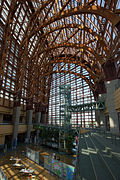Atrium (architecture)
In architecture, an atrium (pl.: atria or atriums)[1] is a large open-air or skylight-covered space surrounded by a building.[2] Atria were a common feature in Ancient Roman dwellings, providing light and ventilation to the interior. Modern atria, as developed in the late 19th and 20th centuries, are often several stories high, with a glazed roof or large windows, and often located immediately beyond a building's main entrance doors (in the lobby).
Atria are a popular design feature because they give their buildings a "feeling of space and light."[3] The atrium has become a key feature of many buildings in recent years.[4] Atria are popular with building users, building designers and building developers. Users like atria because they create a dynamic and stimulating interior that provides shelter from the external environment while maintaining a visual link with that environment. Designers enjoy the opportunity to create new types of spaces in buildings, and developers see atria as prestigious amenities that can increase commercial value and appeal.[5]
Ancient atria


In a
The term was also used for a variety of spaces in public and religious buildings, mostly forms of
19th century: Glazed atrium
The 19th century brought the industrial revolution with great advances in iron and glass manufacturing techniques. Courtyards could then have horizontal glazing overhead, eliminating some of the weather elements from the space and giving birth to the modern atrium.
-
Victoria Hall in Halifax Town Hall, 1863
-
Atrium at the center of the Bradbury Building in Los Angeles
Modern-day atria
Fire control is an important aspect of contemporary atrium design due to criticism that poorly designed atria could allow fire to spread to a building's upper stories more quickly. Another downside to incorporating an atrium is that it typically creates unused vertical space which could otherwise be occupied by additional floors.
One of the main
In Nashville, Tennessee, U.S., the Opryland Hotel hosts 4 different large atria, spanning 9 acres (36,000 m2) of glass ceiling in total, in the hotel above the gardens of: Delta, Cascades, Garden-Conservatories, and Magnolia.
When it opened in 2019, the
, has the largest atrium in the world (by volume) at 29 million cubic feet (820,000 m3).Gallery
-
The atrium of 1 Bligh Street, a Sydney office tower, looking upwards
-
Looking up inside the 32-story atrium of the Shanghai Grand Hyatt, part of theJin Mao Building
-
Atrium of the New York State Theater at Lincoln Center
-
The Grand Piazza atrium inside theSuperStar Virgo
-
Four floor atrium of Gould Hall, College of Built Environments, at the University of Washington
-
TheDowntown Miami42 story atrium
-
Atrium of Complexe Desjardins, Montreal
-
Atrium of Kurayoshi Park Square inKurayoshi, Japan
-
Multi-floor atrium with three see-throughChicago
-
Interior of Wilson Hall atFermi Lab in Illinois
-
Main atrium of Piarco International Airport
-
Atrium (architecture) Salem, Massachusetts PEM * Peabody Essex Museum
See also
References
- ^ "atrium". Cambridge English Dictionary.
- ^ "Atrium". The Free Dictionary. Retrieved 8 April 2014.
- ISBN 9781847976239.
- ISBN 9781902916163.
- S2CID 109961211.
- ISBN 978-0-415-47577-8
- ^ "China opens skyscraper with world's tallest atrium twisting". Construction Review Online. 2019-11-21. Archived from the original on 2020-07-06. Retrieved 2020-07-06.
Further reading
- . Encyclopædia Britannica. Vol. III (9th ed.). 1878. p. 50.
- Roth, Leland M. (1993). Understanding Architecture: Its Elements History and Meaning. Oxford, UK: Westview Press. p. 520. ISBN 0-06-430158-3.

















